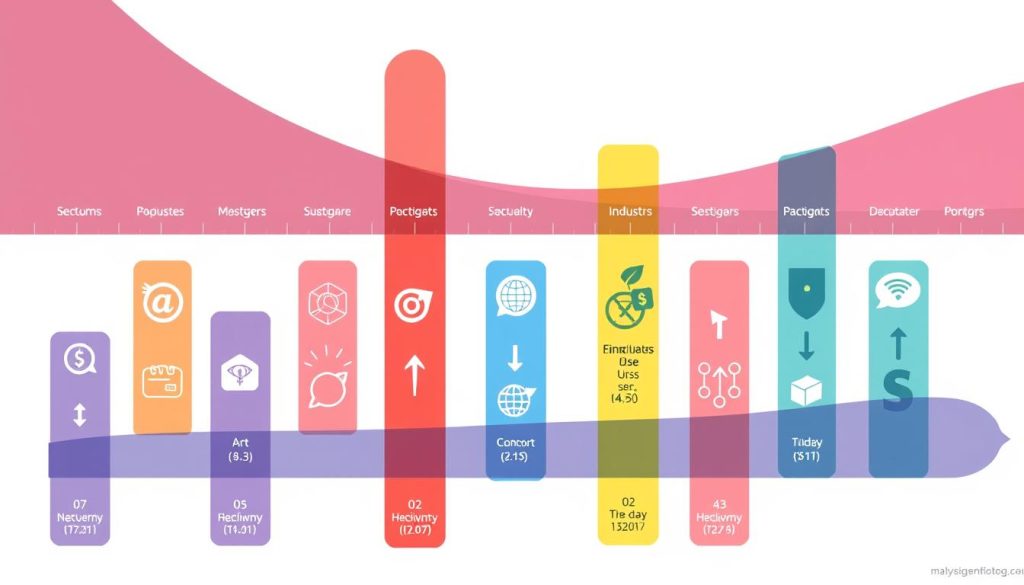Understanding your customers’ buying patterns is key to B2B sales success. B2B buying days are when prospects are most engaged in purchasing. These periods can make or break your sales efforts.
Navigating B2B purchase cycles requires awareness of decision-making factors. Knowing when customers are most receptive helps align your marketing and sales activities. This strategy can drive higher conversion rates and revenue growth.
Key Takeaways
- Discover the strategic importance of understanding B2B buying days in the sales process.
- Learn how to leverage peak activity periods to maximize your sales potential.
- Explore the factors that influence purchasing decisions in the B2B landscape.
- Gain insights into the psychology behind B2B buying behavior and its impact on timing.
- Uncover industry-specific trends and patterns in corporate procurement timelines.
Understanding B2B Buying Days and Their Impact on Sales
B2B sales success hinges on understanding organizational buying decisions. Timing plays a crucial role in closing deals. Let’s explore key elements shaping the B2B buying process.
Sales teams can use this knowledge to optimize their strategies. We’ll examine factors influencing purchase decisions and how to leverage them effectively.
Key Factors Influencing Purchase Decisions
B2B purchasing involves several critical factors. Budgets, departmental needs, and decision-maker availability significantly impact sales timing and outcomes.
Sales professionals can boost success by aligning offerings with organizational priorities. This approach increases chances of securing a successful enterprise sales cycle.
The Psychology Behind B2B Buying Behavior
B2B buying behavior is complex and nuanced. Risk aversion, consensus-building, and long-term relationship desires shape organizational buying processes.
Understanding these motivations helps sales teams craft compelling value propositions. It also aids in building trust with prospects.
How Timing Affects Decision-Making
Sales pitch timing greatly impacts commercial transaction period outcomes. Budget cycles, seasonal trends, and industry-specific patterns influence B2B buying decisions.
Organizations can boost deal closures by anticipating trends and aligning strategies. This approach maximizes success during peak buying periods.
Understanding B2B buying behavior helps sales teams develop effective strategies. It enables better customer engagement and drives successful outcomes.
A holistic view of the B2B buying journey is crucial. It helps navigate the ever-changing landscape of enterprise sales.

Peak Activity Periods in Enterprise Sales Cycles
B2B client acquisition can be tricky. Understanding peak activity periods in enterprise sales cycles gives you an edge. These critical timeframes offer the best chances to boost sales and speed up onboarding.
Industry experts have spotted common patterns across sectors. Many businesses spend most of their budget at the fiscal year’s end. This often leads to a surge in B2B client acquisition.
Some industries show seasonal buying habits. Tech and manufacturing are influenced by product launches and inventory needs.
- Q4 and Year-End Purchasing Spikes: The final quarter often sees more buying as companies use up budgets. This is a prime time for sales teams to act.
- Industry-Specific Patterns: Each sector has unique buying habits. Tech may peak during product launches. Manufacturing might surge during inventory restocking.
- Geographic Variations: Buying behaviors can differ by location. Regional economics and culture can affect purchasing timelines and decisions.
Align your sales strategy with these peak periods for better client acquisition. This knowledge helps you predict and respond to enterprise buying decisions. It can drive more B2B client acquisition and streamline onboarding.
“Understanding the timing and patterns of enterprise buying decisions is crucial for sales teams looking to maximize their impact and efficiency.”
Fiscal Year-End Purchasing Patterns
Companies show unique buying habits as their fiscal year ends. They rush to use remaining budgets and meet deadlines. This creates a golden opportunity for enterprise sales pros to boost their strategies.
Budget Allocation and Spending Deadlines
Organizations often work with fixed yearly budgets. As the year closes, they feel pressed to use leftover funds. This leads to a burst of buying activity.
Smart sales teams can use this info to their advantage. They can match their offerings to customer needs and timelines.
Last-Quarter Buying Surge
The final three months see a jump in B2B sales velocity. Enterprise customer conversion times also speed up. Companies want to make smart purchases that fit long-term goals.
Sales pros who grasp this pattern can engage prospects better. They can offer tailored solutions for year-end needs.
Planning for Year-End Rush
- Anticipate increased buyer activity and adjust sales forecasts accordingly.
- Identify key decision-makers and their specific purchasing timelines.
- Streamline your sales process to facilitate faster enterprise customer conversion times.
- Offer flexible payment terms or leasing options to accommodate budget constraints.
- Emphasize the long-term strategic value of your products or services to justify year-end investments.
Grasping fiscal year-end buying patterns is key for sales teams. It helps them succeed during this busy time. They can take advantage of the increased buying activity.

“Timing is everything in sales, and a keen awareness of fiscal year-end trends can make all the difference in closing deals during the busiest time of the year.”
Seasonal Trends in B2B Buying Days
B2B sales have seasonal trends that affect buying behavior. These patterns vary across industries, creating challenges and opportunities for sales pros. Understanding these trends is key to success.
The fiscal calendar greatly impacts B2B buying days. Many companies make purchases near their fiscal year-end. This leads to increased activity as budgets are finalized and spending deadlines approach.
Sales teams can use this knowledge to their advantage. They can position their offerings strategically to capitalize on the last-quarter buying rush.
Different industries have unique seasonal trends. The tech sector sees more buying before major events or product releases. Manufacturing often slows purchases in summer for maintenance and retooling.
| Industry | Seasonal Buying Trends |
|---|---|
| Technology | Increased activity before industry events and product launches |
| Manufacturing | Decreased purchasing during summer months for maintenance and retooling |
| Healthcare | Surge in procurement during the fourth quarter as budgets are finalized |
Aligning sales strategies with these patterns can be a game-changer. It allows teams to adjust their outreach and marketing campaigns effectively. This helps them make the most of buying activity shifts across different sectors.
“Timing is everything in b2b sales, and the ability to predict seasonal trends can give your organization a distinct competitive edge.” – Industry Expert
To thrive in B2B sales, companies must stay aware of seasonal patterns. Adapting strategies to these trends helps maintain a steady pipeline. It also drives long-term success in the ever-changing business world.
Industry-Specific Purchase Timelines
Corporate procurement timelines vary across industries, each with unique buying patterns and seasonal trends. Understanding these differences helps sales professionals align their strategies effectively. They can capitalize on distinct opportunities by knowing industry-specific purchase timelines.
Technology Sector Buying Patterns
The tech industry’s procurement timelines revolve around new product launches and upgrades. Companies allocate budgets early in the fiscal year to implement cutting-edge solutions. This leads to increased buying activity during the first and second quarters.
Manufacturing Industry Cycles
Production schedules and inventory management heavily influence the manufacturing industry. Manufacturers focus on upgrading equipment and securing supplies in the third and fourth quarters. This preparation for the upcoming year’s demands causes a spike in purchasing activity.
Healthcare Procurement Seasons
Healthcare operates on unique procurement timelines with specific buying seasons. Hospitals often allocate budgets for equipment, supplies, and IT systems at the fiscal year’s start. This creates a surge in first and second-quarter purchases.
The industry also experiences a year-end rush as organizations use remaining funds. This leads to increased buying activity in the fourth quarter.
| Industry | Peak Buying Periods | Key Drivers |
|---|---|---|
| Technology | Q1 and Q2 | New product launches, technology upgrades |
| Manufacturing | Q3 and Q4 | Production schedules, inventory management |
| Healthcare | Q1, Q2, and Q4 | Budget allocation, medical equipment and IT purchases |

Knowledge of industry-specific timelines helps sales professionals strategically align their approaches. They can maximize opportunities and engage effectively with target markets. Adapting to each sector’s buying patterns gives organizations a competitive edge in enterprise sales.
Optimizing Your Sales Strategy for Peak Buying Days
Understanding organizational buying processes and commercial transaction periods is key for sales teams. These insights help maximize impact during crucial sales times. Here are strategies to boost your sales during peak buying days:
- Align Your Marketing Efforts: Time your campaigns with peak buying periods. Craft messages that address your audience’s needs during high-activity seasons.
- Prepare Your Sales Team: Equip your reps with knowledge about industry trends and buyer personas. Train them in effective sales techniques for these critical moments.
- Allocate Resources Strategically: Invest in extra sales and support staff during peak buying days. Provide additional marketing materials to boost your capacity and conversion rates.
- Personalize Your Outreach: Use data-driven insights to tailor your sales approach. Customize messages and offers to meet each prospect’s unique needs and preferences.
Sync your sales and marketing strategies with organizational buying processes. This alignment positions your business for success during peak buying days.
Take advantage of heightened activity in commercial transaction periods. Your well-timed approach can lead to increased sales and stronger customer relationships.
| Strategies | Potential Benefits |
|---|---|
| Align Marketing Efforts | Increased brand visibility, targeted messaging, and higher conversion rates during peak buying periods. |
| Prepare Sales Team | Improved sales effectiveness, enhanced prospect engagement, and higher close rates. |
| Allocate Resources Strategically | Increased sales capacity, improved customer experience, and maximized revenue generation. |
| Personalize Outreach | Stronger customer relationships, increased trust, and higher customer retention rates. |

“Timing is everything in sales. By aligning your strategies with the ebb and flow of organizational buying processes, you can position your business for success and capitalize on the heightened activity during peak buying days.”
The Role of Decision-Makers in Corporate Procurement
Corporate procurement involves multiple decision-makers, each with unique priorities and concerns. Sales professionals must understand these dynamics to engage stakeholders effectively. This approach can speed up B2B client acquisition timeframes.
Recognizing key players in the B2B buying process is crucial for successful client acquisition. By tailoring their approach, sales teams can connect with the right stakeholders more efficiently.
C-Suite Involvement Patterns
C-suite executives play a vital role in large corporate purchases. They focus on strategic implications and long-term return on investment. Engaging them requires a data-driven approach that aligns with company goals.
Department Head Influence
Department heads significantly influence corporate client onboarding durations. These mid-level managers know their team’s daily challenges and operational needs well. Addressing their concerns and showing how solutions enhance productivity is crucial.
Understanding C-suite and department head roles helps sales professionals navigate the B2B buying landscape. This knowledge allows them to tailor their approach and shorten client acquisition timeframes.
Digital Engagement Patterns During B2B Purchase Cycles
B2B sales success hinges on grasping prospects’ digital engagement patterns. These patterns offer vital clues about customer decision-making. By analyzing online behavior, businesses can refine their marketing and sales approaches.
Enterprise customer conversion times and B2B sales velocity are critical metrics. They show how digital channels shape the buyer’s journey. Monitoring these patterns helps businesses tailor their outreach effectively.
The Evolving Role of Digital Channels
B2B buyers now rely heavily on digital platforms for purchase decisions. These include blog posts, webinars, product demos, and social media. The online landscape has become crucial throughout the buyer’s journey.
A strong online presence is essential to attract target audiences. Valuable content addressing prospect challenges nurtures them through the sales funnel. Data-driven insights can optimize content strategy and sales velocity.
- Businesses must maintain a strong online presence to capture the attention of their target audience and position themselves as trusted industry experts.
- Delivering valuable, relevant content that addresses the specific pain points and challenges of your prospects can help nurture them through the sales funnel.
- Leveraging data-driven insights to understand how your audience engages with your digital assets can inform your content strategy and optimize your sales velocity.
Adapting to Changing Buyer Behavior
B2B businesses must adapt their digital strategies to meet evolving prospect needs. Monitoring enterprise customer conversion times and B2B sales velocity is key. This helps identify ways to improve sales processes and buyer experiences.
“In today’s digital-first world, understanding the nuances of B2B buying behavior is essential for any organization looking to stay ahead of the curve.”
| Digital Channel | Engagement During Purchase Cycle | Impact on Sales Velocity |
|---|---|---|
| Webinars | High during early research phase | Increases enterprise customer conversion times |
| Social Media | Consistent throughout the buyer’s journey | Enhances B2B sales velocity through targeted outreach |
| Product Demos | Peak during final evaluation stage | Accelerates enterprise customer conversion times |
Understanding Business-to-Business Purchase Cycles
B2B buying cycles are complex and crucial for sales pros. This section explores long-term vs. short-term decisions and economic impacts on these cycles.
Long-term vs. Short-term Decision Making
B2B purchases vary in timeframe. Some focus on strategic investments for long-term goals. Others prioritize tactical buys for immediate needs.
Sales teams must grasp this difference. It helps them tailor approaches and build lasting client relationships.
Impact of Economic Conditions
The economy greatly affects B2B buying cycles. Economic uncertainty can lead to cautious spending and longer decision-making.
Prosperity may spur ambitious investments and faster purchases. Sales strategies must adapt to these market shifts.
Staying aware of B2B buying trends is vital. It helps teams seize peak activity periods. They can build stronger relationships and offer valuable solutions.
“Understanding the nuances of b2b buying days and business-to-business purchase cycles is the key to unlocking sustainable sales success in today’s dynamic market.”
Leveraging Data Analytics to Predict Buying Days
B2B sales success hinges on staying ahead. Data analytics offers a powerful solution for predicting corporate procurement timelines. Companies can fine-tune strategies by analyzing enterprise sales cycles.
Historical data analysis uncovers hidden patterns and trends. Predictive models help anticipate purchasing decisions, optimizing outreach and resource allocation. This data-driven approach enhances sales effectiveness and boosts business agility.
Refining predictive models is crucial in the evolving B2B landscape. Regular updates to analytics capabilities maintain a competitive edge. This ensures sales strategies align with changing corporate procurement timelines.
Data analytics empowers businesses to navigate complex enterprise sales cycles. It drives growth and success in the B2B marketplace. Strategic implementation is key to achieving precision in sales efforts.




